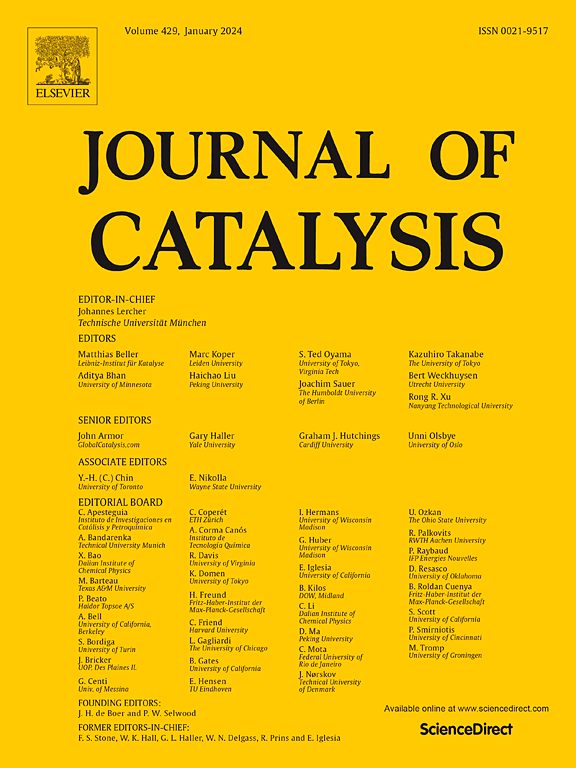通过DFT和微动力学模型研究了rh催化醋酸烯丙酯氢甲酰化反应的微观机制和区域选择性的基本因素
IF 6.5
1区 化学
Q2 CHEMISTRY, PHYSICAL
引用次数: 0
摘要
醋酸烯丙酯直接氢甲酰化加氢是一条具有重要工业潜力和市场前景的生产1,4-丁二醇的新途径。本研究采用密度泛函理论(DFT)和微动力学模型(MKM)对两种具有不同产物分布的具有代表性的rh基催化剂(RhH(CO)2(Xantphos)和RhH(CO)2(PPh3)2)进行了比较研究,系统地阐明了提高该反应选择性的机理和调控原理。理论计算表明,区域选择性主要由烯烃插入步骤决定。黄磷配体降低了Rh中心的电子密度,为线性途径提供了有利的空间环境。此外,醋酸烯丙酯中的乙酰氧基与Rh羰基产生排斥作用,使Rh优先与β-C配合,从而显著促进4-乙酰氧基丁醛的形成。相比之下,pph3修饰的Rh催化剂在支链路径上表现出较低的空间位阻,从而有利于支链醛的形成。实验研究表明,醋酸烯丙酯的氢解反应主要发生在非配位的Rh位点,H2浓度的升高和温度的升高会促进这一副反应的发生。对于Xantphos, MKM模拟表明,增加压力和优化合成气组成(CO/H2 = 0.5-2)可以导致线性醛选择性超过98 %。同样,在PPh3体系中,高压和接近等摩尔的合成气比有利于支醛的形成。这些发现揭示了配体设计、反应条件和选择性之间的内在关系,建立了乙酰氧基功能化烯烃氢甲酰化的结构-活性框架。该研究为高效催化剂的合理设计提供了重要的理论指导,并推动了规模化1,4- bdo生产工艺的发展。本文章由计算机程序翻译,如有差异,请以英文原文为准。


The microscopic mechanisms and essential factors governing regioselectivity in Rh-catalyzed hydroformylation of allyl acetate via DFT and microkinetic modeling
The direct hydroformylation of allyl acetate followed by hydrogenation represents a novel route for 1,4-butanediol production with significant industrial potential and market prospects. In this study, we employed Density Functional Theory (DFT) and Microkinetic Modeling (MKM) to comparatively investigate two representative Rh-based catalysts with distinct product distributions (RhH(CO)2(Xantphos) and RhH(CO)2(PPh3)2), systematically elucidate the mechanisms for improving the selectivity and regulation principles of this reaction. Theoretical calculations reveal that the regioselectivity is primarily determined by the olefin insertion step. Xantphos ligand reduces the electron density of the Rh center and provides a sterically favorable environment for the linear pathway. Additionally, the acetoxy group in allyl acetate exerts a repulsive interaction with the Rh-carbonyl, directing Rh to preferentially coordinate with the β-C, thereby significantly enhancing the formation of 4-acetoxybutyraldehyde. In contrast, the PPh3-modified Rh catalyst exhibits lower steric hindrance along the branched pathway, thus favoring the formation of branched aldehydes. Experimental investigations demonstrate that hydrogenolysis of allyl acetate predominantly occurs at the uncoordinated Rh sites, and the elevated H2 concentration and higher temperature will promote this side reaction. For Xantphos, MKM simulations indicate that the increased pressure and optimized syngas composition (CO/H2 = 0.5–2) can lead to linear aldehyde selectivity exceeding 98 %. Similarly, in the PPh3 system, high pressure and a near-equimolar syngas ratio favor the formation of branched aldehyde. These findings unveil the intrinsic relationships between ligand design, reaction conditions and selectivity, establishing a structure–activity framework for hydroformylation of acetoxy-functionalized olefins. This work provides critical theoretical guidance for the rational design of efficient catalysts and advances the development of scalable 1,4-BDO production process.
求助全文
通过发布文献求助,成功后即可免费获取论文全文。
去求助
来源期刊

Journal of Catalysis
工程技术-工程:化工
CiteScore
12.30
自引率
5.50%
发文量
447
审稿时长
31 days
期刊介绍:
The Journal of Catalysis publishes scholarly articles on both heterogeneous and homogeneous catalysis, covering a wide range of chemical transformations. These include various types of catalysis, such as those mediated by photons, plasmons, and electrons. The focus of the studies is to understand the relationship between catalytic function and the underlying chemical properties of surfaces and metal complexes.
The articles in the journal offer innovative concepts and explore the synthesis and kinetics of inorganic solids and homogeneous complexes. Furthermore, they discuss spectroscopic techniques for characterizing catalysts, investigate the interaction of probes and reacting species with catalysts, and employ theoretical methods.
The research presented in the journal should have direct relevance to the field of catalytic processes, addressing either fundamental aspects or applications of catalysis.
 求助内容:
求助内容: 应助结果提醒方式:
应助结果提醒方式:


